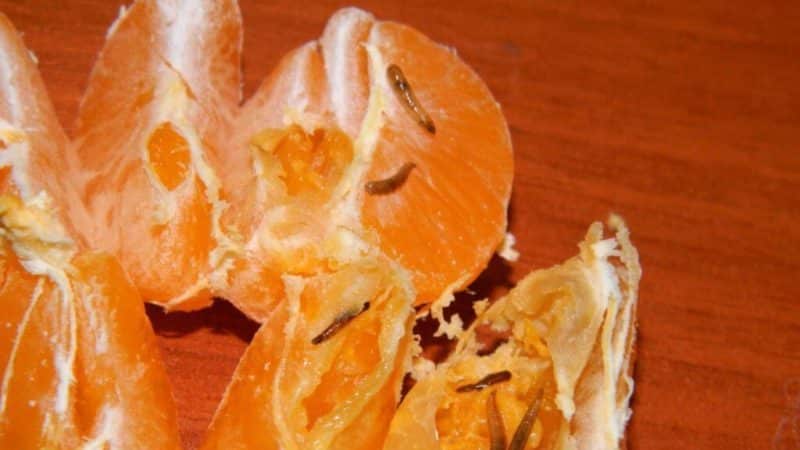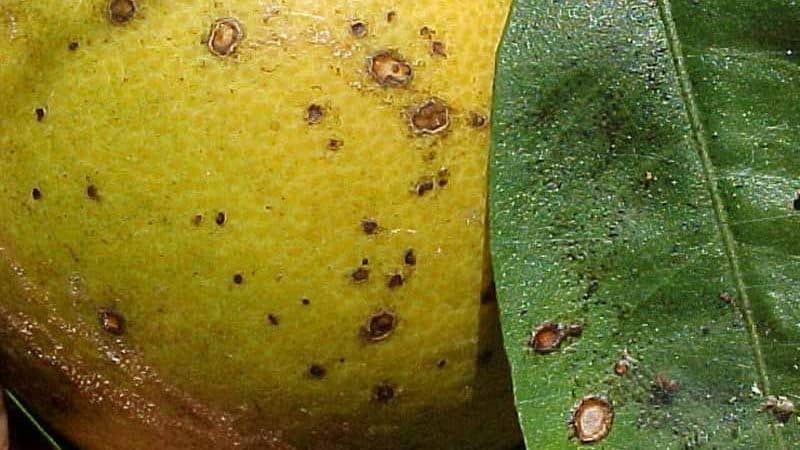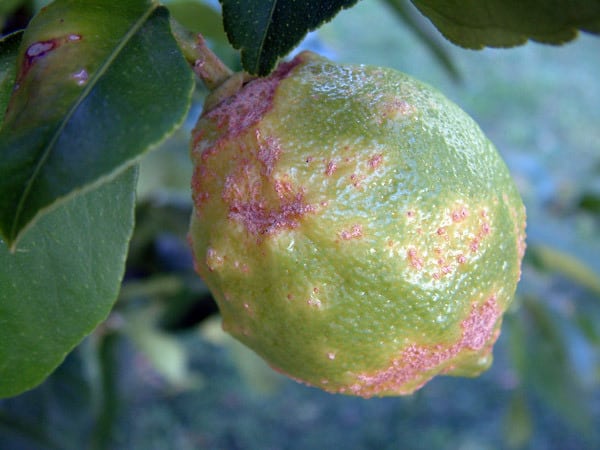How to save tangerines from worms and diseases
The tangerine tree is often grown as a houseplant. In order for it to please with beautiful flowering and tasty fruits, it is properly cared for: watering conditions are observed, fertilizing is applied, regularly replanted and protected from diseases. If the rules of care are violated or the surroundings are improper, a tangerine growing in an apartment can become infected with infections and pests.
Not all diseases are treatable, even if detected early. This also applies to pests. If the fruits are already infested with worms, the harvest cannot be saved. How to protect tangerines from such problems, how to treat them and whether it is possible to eat damaged fruits - further in the article.
Can there be worms in tangerines?

Worms in tangerines are a rare but real phenomenon. They are found in fruits purchased in supermarkets. In the fruits of indoor trees, the risk of detecting larvae is extremely low.
There are only two types of insects that lay larvae in citrus fruits:
- Mediterranean fly – lays larvae that look like maggots with a sharp black spike on the tail;
- stalk - a thin worm that feeds on the pulp of a tangerine and gnaws out passages in it.
Parasites get into tangerines while the fruits are still hanging on the tree. Pests are detected in the pulp by the presence of dark spots, holes and damage on the peel.
Fruits growing on indoor tangerines are rarely affected by such pests.This is only possible if during the warm season the pot with the tree is placed in the garden or on an open loggia.
There is no need to specifically treat indoor tangerines against worms with insecticides. This is done in the spring, before flowering, if such a problem arose in the previous year.
If larvae were found in tangerines, you should, of course, not eat them. The waste products of these insects cause intoxication of the body.
Main diseases of the tangerine tree
At home, the tangerine tree is less susceptible to disease than in open ground, but there is still a risk of the plant becoming infected. This happens when the rules of care are violated, or when an infected soil and planting material in proximity to diseased plants. The chances of a tangerine becoming infected are especially high in the summer if the pot is in the garden or on the balcony.
Indoor citrus trees suffer from common and specific diseases. Some of them are easy to treat, while others are impossible to fight.
Anthracnose
The causative agent of anthracnose is a fungus. Without timely treatment of the disease, branches, young shoots and leaves die off, which causes the death of the plant. The infection also has a negative effect on the fruits. They become bitter and sour and acquire an unpleasant aroma. The duration of their storage is reduced.
Note! Tangerine fruits can become infected with anthracnose during storage.
With timely treatment, saving a tangerine affected by anthracnose will not be difficult. It is important to know the symptoms of the disease:
- At the initial stages of the disease, the leaves become covered with light olive-colored spots. Over time, their color becomes more intense.With high humidity they turn brown.
- Small dark spots appear on the tops of the shoots. Soon the branches become brown and then light gray. Swellings and convex formations appear on them.
- Red spots form on the white affected inflorescences. Soon they fall off. The same happens with young ovaries.
- Dark spots appear on the fruit around the peduncle, which gradually increase in size, damaging the rind. It becomes dark brown and soft.
The reason for the development of anthracnose is high humidity and violation of care rules.
To treat the disease, remove all affected parts of the plant. The cut areas are treated with garden varnish. Then the tree is sprayed with an antifungal agent:
- "Fitosporin". A biological product that is safe for people, the environment and animals.
- "Topaz". A fungicide that is highly effective. The product is poisonous - if the plant was treated during flowering or fruiting, it is not recommended to eat the fruits.
- Iodine with milk. A folk remedy with an antifungal effect. For 4 liters of water take 1 liter of milk and 30 drops of iodine.
The plants that have been cleared of the affected parts are treated with the means described. It is necessary to do at least 3 treatments with an interval of 1-2 weeks.
Gommoz
Hommosis is a fungal disease. It leads to peeling of the bark, death of roots and shoots. Sometimes the infection also affects the fruits, manifesting itself in the form of brown, weeping rot.
The disease is recognized by the following symptoms:
- long brown or red spots appear on the branches and trunk;
- cracks appear on the bark, from which a golden-yellow liquid (gum) is released;
- without timely treatment, the affected branches die;
- after some time the leaves die off;
- Brown weeping spots appear on the fruits.
There are several reasons for the development of diseases:
- excessively deep planting with deepening of the root collar;
- contaminated soil and planting material;
- lack of drainage;
- fluid stagnation;
- excess nitrogenous fertilizers;
- lack of potassium and phosphorus fertilizers;
- mechanical damage.
To revive an indoor tree, the affected areas are cleaned. They are treated with a solution prepared from 1 liter of water and 2 tbsp. l. copper sulfate and 100 g of lime. Then lubricate with garden varnish. The treatment is done several times until the problem disappears completely.
Only the trunk of the plant is treated. Branches affected by gommosis are removed.
Important! In the later stages, when the disease affects the leaves, the tree cannot be saved. In this case, it will have to be destroyed.
Wartiness
Warts are caused by a fungal infection. This disease leads to the fall of inflorescences, leaves and ovaries, death of shoots, and damage to the crop. This disease of the tangerine tree is easily treated at home, but without timely intervention it causes the death of the plant.
To save a tangerine infected with warts, it is important to promptly identify the symptoms:
- A translucent yellow coating appears in the form of small spots on tangerine leaves. Soon, pinkish-gray growths (warts) form in these areas.
- Warts form on shoots. Over time, they combine and turn into a large growth. Because of this, the branches may die.
- Orange spots appear on the fruits, different from the main shade of the peel. They acquire a brownish-red hue and grow. Tangerines and unformed ovaries fall off.
Without eliminating the causes of the disease in homemade tangerines, treatment is impossible. The fungus becomes active at elevated room temperatures and high air humidity.
To combat the disease, the affected parts of the plant trimmed. The cut areas are lubricated with garden varnish. The tree is sprayed with a solution of copper sulfate.

Late blight
Late blight is a fungal disease that is quite difficult to cure. If the disease has affected only the above-ground part of the tree, it can be saved. In cases of damage to the root system, tangerine cannot be cured.
An oily brown ring appears on the trunk. The plant begins to dry out, the leaves fall off, and eventually the tree dies.
Most often, the disease affects young seedlings. The risk of infection in tangerines grafted onto oranges is especially high.
When signs of late blight appear, dig up the plant and check the roots. If they show signs of disease, the tree is thrown away.
If the disease has affected only the trunk, then the diseased tissue is scraped out. Mandarin is sprayed with Topaz or another fungicide. Additionally, the cleaned area is lubricated with garden varnish. Several such treatments are carried out.
Citrus cancer
Citrus canker is a bacterial disease. It affects all above-ground parts of the plant, leading to its death.
Small bright dark brown spots form on the leaves and fruits. They begin to dry out and fall off.
The disease cannot be cured. The infected plant will have to be destroyed.

Malsecco
Malsecco is an infectious disease. The pathogen spores spread through the air. They are also transmitted through infected garden tools and planting material.
This is interesting! In open ground, a dangerous disease affects tangerines in the spring, and at home - from autumn to spring.
Malsecco symptoms are specific:
- The branches are the first to suffer - when cut they acquire an orange-red color;
- the leaves fall off and the petioles remain on the branches.
The disease cannot be treated. The affected mandarin is destroyed.
Root rot
Root rot is a disease caused by a fungal infection. It affects the root system of the tangerine, leading to its rotting. Signs of infection usually appear when the disease is in an advanced state. Due to improper functioning of the root system, the leaves on the tree turn yellow and fall off, inflorescences do not form and fruits do not set.
Reasons for the development of root rot:
- deep landing;
- excessive watering;
- contaminated soil or planting material;
- lack of drainage;
- using cold water for irrigation.
How to deal with the disease:
- The plant is dug up, the root system is cleared of soil and inspected.
- Infected roots are cut off. Before use, the knife is disinfected.
- The roots are washed with a light pink solution of potassium permanganate. The cut areas are sprinkled with ash.
- The root system is soaked in “Kornevin” for 12 hours. Then the tree is transplanted into new disinfected soil without deepening the root collar.
- The number of waterings is temporarily reduced. The leaves are wiped with a damp cloth every other day.
Tristeza
Tristeza is a viral disease that affects the bark of the plant. In varieties that are immune to it, the infection is in a latent state. That is, if graft a branch, in the cells of which this virus is located, the unstable rootstock will soon become ill.
The virus affects trees 5 years old or more. The symptoms of tristeza are as follows:
- the leaves become dull, acquire a bronze tint, the veins turn yellow, the leaf blades fall off;
- branches and young shoots die and fall off;
- the fruits change color and fall off, the inflorescences and ovaries (if the disease is activated at this stage) fall off.
Like other viral diseases, tristeza has no cure. The affected plant is removed.
Xylopsorosis
Xylopsorosis is a viral disease. Its peculiarity is that the infection can remain latent for up to 10 years. The virus activates unexpectedly and develops rapidly.
The infection affects the tree bark. This leads to cracking and peeling. Gum is released. Diseased parts of the plant die.
The disease cannot be treated. Sick tangerines must be destroyed.
Diseases due to lack of nutrients
Sometimes signs of a lack of micro- and macroelements are confused with symptoms of diseases. The most common cases:
- Nitrogen deficiency. Light yellow dots appear on the leaves. Over time, the entire leaf blade turns yellow and fades.
- Lack of phosphorus. At the end, the leaf plate acquires a rusty tint. The color of the rest of the leaf fades.
- Potassium deficiency. Folds and dents on the leaf plate near the veins.
- Lack of manganese, zinc and iron. The leaves become pale, yellow-green. The bright green veins appear to contrast.
When the alkaline balance of the soil is disturbed, leaves fall.
How to understand that a tree has died

Many diseases without timely treatment lead to the death of the tangerine tree. How to understand that a plant can no longer be saved? Focus on the following signs:
- Leaves fell from the tree. You should pay attention to this sign only in conjunction with other symptoms.Leaf fall also begins with a lack of microelements, and sometimes in winter.
- The shoots fall off. The branches became dry and brittle.
- Mandarin has stopped developing.
Individually, the symptoms do not always indicate the death of the tangerine. The plant died if they were present together.
How to protect plants
Many diseases are difficult to treat. It is much easier to carry out preventive measures in a timely manner:
- soil, planting material and garden tools are disinfected;
- control pests in a timely manner;
- follow the rules and frequency of watering;
- when planting, use drainage and containers with holes;
- contribute regularly feeding;
- replant the plants as the container is filled with the root system;
- follow the landing rules;
- Not grow tangerines next to sick indoor plants.
Conclusion
Wormy tangerines are a rare occurrence. Often found only in fruits purchased at the grocery store. Eating such fruits is dangerous for your health.
Tangerine diseases even affect indoor plants. This usually happens when care rules are violated. Less commonly, the cause of infection is planting material already contaminated with microorganisms. In most cases, it is possible to save the tree. The main thing is to recognize the symptoms in time and begin treatment.